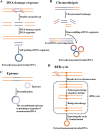Current understanding of extrachromosomal circular DNA in cancer pathogenesis and therapeutic resistance
- PMID: 32928268
- PMCID: PMC7491193
- DOI: 10.1186/s13045-020-00960-9
Current understanding of extrachromosomal circular DNA in cancer pathogenesis and therapeutic resistance
Abstract
Extrachromosomal circular DNA was recently found to be particularly abundant in multiple human cancer cells, although its frequency varies among different tumor types. Elevated levels of extrachromosomal circular DNA have been considered an effective biomarker of cancer pathogenesis. Multiple reports have demonstrated that the amplification of oncogenes and therapeutic resistance genes located on extrachromosomal DNA is a frequent event that drives intratumoral genetic heterogeneity and provides a potential evolutionary advantage. This review highlights the current understanding of the extrachromosomal circular DNA present in the tissues and circulation of patients with advanced cancers and provides a detailed discussion of their substantial roles in tumor regulation. Confirming the presence of cancer-related extrachromosomal circular DNA would provide a putative testing strategy for the precision diagnosis and treatment of human malignancies in clinical practice.
Keywords: Biomarkers; Cancer pathogenesis; Clinical utility; Extrachromosomal circular DNA; Oncogene amplification; Therapeutic resistance.
Conflict of interest statement
We declare no conflicts of interest.
Figures




Similar articles
-
Novel insights into extrachromosomal DNA: redefining the onco-drivers of tumor progression.J Exp Clin Cancer Res. 2020 Oct 12;39(1):215. doi: 10.1186/s13046-020-01726-4. J Exp Clin Cancer Res. 2020. PMID: 33046109 Free PMC article. Review.
-
Classification of extrachromosomal circular DNA with a focus on the role of extrachromosomal DNA (ecDNA) in tumor heterogeneity and progression.Biochim Biophys Acta Rev Cancer. 2020 Aug;1874(1):188392. doi: 10.1016/j.bbcan.2020.188392. Epub 2020 Jul 28. Biochim Biophys Acta Rev Cancer. 2020. PMID: 32735964 Review.
-
Extra chromosomal DNA in different cancers: Individual genome with important biological functions.Crit Rev Oncol Hematol. 2021 Oct;166:103477. doi: 10.1016/j.critrevonc.2021.103477. Epub 2021 Sep 14. Crit Rev Oncol Hematol. 2021. PMID: 34534658 Review.
-
Circular DNA Throws Gene Regulation for a Loop.Cancer Discov. 2020 Feb;10(2):170. doi: 10.1158/2159-8290.CD-ND2019-016. Epub 2020 Jan 6. Cancer Discov. 2020. PMID: 31907167
-
New mechanisms of gene amplification in drug resistance (the episome model).Cancer Treat Res. 1991;57:1-11. doi: 10.1007/978-1-4615-3872-1_1. Cancer Treat Res. 1991. PMID: 1686710 Review. No abstract available.
Cited by
-
Long extrachromosomal circular DNA identification by fusing sequence-derived features of physicochemical properties and nucleotide distribution patterns.Sci Rep. 2024 Apr 24;14(1):9466. doi: 10.1038/s41598-024-57457-5. Sci Rep. 2024. PMID: 38658614 Free PMC article.
-
Sequence characterization of eccDNA content in glyphosate sensitive and resistant Palmer amaranth from geographically distant populations.PLoS One. 2022 Sep 14;17(9):e0260906. doi: 10.1371/journal.pone.0260906. eCollection 2022. PLoS One. 2022. PMID: 36103503 Free PMC article.
-
FLED: a full-length eccDNA detector for long-reads sequencing data.Brief Bioinform. 2023 Sep 22;24(6):bbad388. doi: 10.1093/bib/bbad388. Brief Bioinform. 2023. PMID: 37930031 Free PMC article.
-
Extrachromosomal Circular DNA: Category, Biogenesis, Recognition, and Functions.Front Vet Sci. 2021 Sep 9;8:693641. doi: 10.3389/fvets.2021.693641. eCollection 2021. Front Vet Sci. 2021. PMID: 34568472 Free PMC article. Review.
-
Small ring has big potential: insights into extrachromosomal DNA in cancer.Cancer Cell Int. 2021 Apr 26;21(1):236. doi: 10.1186/s12935-021-01936-6. Cancer Cell Int. 2021. PMID: 33902601 Free PMC article. Review.
References
-
- Amils R, Irazabal N, Moreira D, Abad JP, Marin I. Genomic organization analysis of acidophilic chemolithotrophic bacteria using pulsed field gel electrophoretic techniques. Biochimie. 1998;80(11):911–921. - PubMed
-
- Barten R, Meyer TF. DNA circle formation in Neisseria gonorrhoeae: a possible intermediate in diverse genomic recombination processes. Molecular & general genetics : MGG. 2001;264(5):691–701. - PubMed
Publication types
MeSH terms
Substances
LinkOut - more resources
Full Text Sources
Other Literature Sources
Medical
Research Materials
Miscellaneous

